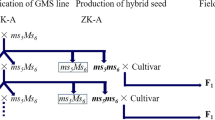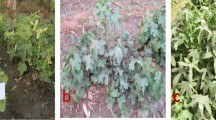Abstract
Cotton although is an autogamous species could be cross pollinated under favorable climate conditions and/or in the presence of pollinators. The coexistence of cotton with Malvaceae species raises questions on the possibility pollen to be exchanged among Malvaceae species and on the resulted consequences. The present work was undertaken to evaluate the in situ response of cotton flowers (G.hirsutum L, G. barbadense L.) and their F1 interspecific hybrids when are artificially pollinated with Malva sylvestris L., Hibiscus syriacus L. and Abelmoschus esculentus Moench. Furthermore, an in vitro protocol was attempted to support embryos’ growth in order to produce viable progenies originating from crosses between cotton and the aforementioned Malvaceae species. The obtained results gave evidence that pollen from the above Malvaceae species stimulated cotton ovaries without successful hybridization. The interaction between pollen and cotton’s stigmas was higher at early stages when M. sylvestris was used as pollinator but in crosses with H. syriacus and A. esculentus more ovules were activated as revealed by the percentage of carpodesis and life-time of bolls onto maternal plants. Only crosses between cotton with okra produced cotton seeds under in situ conditions. The in vitro embryo-ovule culture protocol, used, increased the number of regenerated cotton plants, especially in crosses among F1 interspecific cotton hybrids and A. esculentus. In this case, regenerated plants were recombinant aneuploids, combining traits from both cotton species. This novel cotton germplasm possessing unique chromosome rearrangements, at aneuploid level could be proved useful after cytogenetic, molecular or QTL genetic analysis referring to important agronomic traits.






Similar content being viewed by others
References
Bourgou L, Sanfo D, Tiemtore CB, Traore O, Sanou J, Traore K (2013a) Assessment of possible hybridization between Bt cotton (Gossypium hirsutum L.) and other Malvaceae species cultivated in Burkina Faso. Afr J Biotechnol 12(14):1609–1616. https://doi.org/10.5897/AJB12.2012
Bourgou L, Sanfo D, Tiemtore CB, Traore O, Sanou J, Traore K (2013b) Assessment of Bollgard II cotton pollen mediated transgenes flow to conventional cotton in the farming conditions of Burkina Faso. Afr J Biotechnol 12(33):5192–5199. https://doi.org/10.5897/AJB12.1931
Brown MS (1947) A case of spontaneous reduction of chromosome number in somatic tissue of cotton. Am J Bot 34:384–388. https://doi.org/10.1002/j.1537-2197.1947.tb13005.x
Dolezel J, Greilhuber J, Lucretti S, Meister A, Lysak MA, Nardi L, Obermayer R (1998) Plant genome size estimation by flow cytometry: inter-laboratory comparison. Ann Bot 82(A):17–26. https://doi.org/10.1093/oxfordjournals.aob.a010312
Galbraith DW, Harkins KR, Maddox JM, Ayres NM, Sharma DB, Firoozabady E (1983) Rapid flow cytometric analysis of the cell cycle in the intact plant tissues. Science 220(4601):1049–1051. https://doi.org/10.1126/science.220.4601.1049
Hadley HH, Openshaw SJ (1980) Interspecific and intergeneric hybridization. In: Fehr WR, Hadley HH (eds) Hybridization of crop plants. American Society of Agronomy, Madison
Kantartzi S, Roupakias DG (2008) Production of aneuploids of the cotton hybrid G. barbadense × G. hirsutum L. via intergeneric pollination with Abelmoschus esculentus. Euphytica 161:319–327. https://doi.org/10.1007/s10681-007-9550-z
Kantartzi S, Roupakias DG (2009) In vitro gynogenesis in cotton (Gossypium sp.). Plant Cell Tissue Organ Cult 96:53–57. https://doi.org/10.1007/s11240-008-9459-9
Kantartzi S, Roupakias DG (2010) Study of apomictic seed formation in interspecific, Gossypium barbadense × G. hirsutum, cotton hybrids. Int J Bot 6(2):164–169
Lazaridou TB, Pankou CI, Xynias IN, Roupakias DG (2017) Effect of the 1BL.1RS wheat-rye translocation on the androgenic response in spring bread wheat. Cytol Genet 51(6):485–490. https://doi.org/10.3103/S009545271706007X
Mavromatis AG, Kantartzi SK, Vlachostergios DN, Xynias IN, Skaracis GN, Roupakias DG (2005) Induction of embryo development and fixation of partial interspecific lines after pollination of F 1 cotton interspecific hybrids (Gossypium barbadense × Gossypium hirsutum) with pollen from Hibiscus cannabinus. Aust J Agric Res 56:1101–1109. https://doi.org/10.1071/AR04241
Mavromatis AG, Kantarzi SK, Vlahostergios D, Skaracis G, Roupakias D (2004) Doupled haploids from cotton interspecific hybrids (G. hirsutum × G. barbadense): a new source of genetic variability for cotton breeding. In: COST action meeting of WG 851./WG3, Tulln, Austria Sept. 2004.
Mavromatis AG, Khah EM, Vlahostergios D, Roupakias DG (2012) Wide Hybridization as a scientific tool to understand the genetic background of cotton. In: 1st international conference on science industry and trade of cotton—Oct 2–4, 2012, Gorgan, IRAN.
Mehetre SS (1993) Distant hybridization in cotton breeding-intergeneric hybridization (an overview). J Cotton Res Dev 7(2):179–192
Mehetre SS, Thombre MV, Tyyab MA (1980) Cytomorphological studies in an intergeneric hybrid between Gossypium hirsutum L. (2n = 52) and Hibiscus panduraeformis Burm. Euphytica 29:323–330. https://doi.org/10.1007/BF00025130
Mori T, Kuroiwa H, Higashiyama T, Kuroiwa T (2006) Generative cell specific is essential for angiosperm fertilization. Nat Cell Biol 8:64–71. https://doi.org/10.1038/ncb1345
Murashige T, Skoog F (1962) A revised medium for rapid growth and bioassays with tobacco tissue cultures. Physiol Plant 15:473–497. https://doi.org/10.1111/j.1399-3054.1962.tb08052.x
Myles EL, Endrizzi JE (1989) Aneuploids induced by deficiencies of chromosome 9 and analysis of the time of nondisjunction in cotton. Genome 32(1):12–18. https://doi.org/10.1139/g89-403
Roupakias DG, Mavromatis AG (2010) Cotton Breeding in the 21st Century. In: Wakelyn PJ, Chaudhry MR (eds) Cotton: technology for the 21st Century. International Cotton Advisory Committee, Washington, DC
Stewart JM, Hsu CL (1978) Hybridization of diploid and tetraploid cottons through in-ovule embryo culture. J Hered 69:404–408. https://doi.org/10.1093/oxfordjournals.jhered.a108982
Swanson R, Edlund AF, Preuss D (2004) Species specificity in pollen-pistil interactions. Ann Rev Genet 38:793–818. https://doi.org/10.1146/annurev.genet.38.072902.092356
Tate JA, Aguilar JF, Wagstaff SJ, La Duke J, Bodo TA, Slotta J, Simpson BB (2005) Phylogenetic relationships within the Trible Malveae (Malvaceae) as inferred from ITS sequence data. Am J Bot 92(4):584–602. https://doi.org/10.3732/ajb.92.4.584
Tyagi P, Bowman DT, Bourland FM, Edmisten K, Campbell BT, Fraser DE, Wallace T, Kuraparthy V (2014) Components of hybrid vigor in upland cotton (Gossypium hirsutum L.) and their relationship with environment. Euphytica 195(1):117–127. https://doi.org/10.1007/s10681-013-0987-y
Vlachostergios DN, Mavromatis AG, Kantartzi SK, Roupakias DG (2007) In-vitro development of ovules obtained after pollination of cotton (Gossypium spp) flowers with pollen from okra (Abelmoschus esculentus L. Moench). Plant Cell Tissue Organ Cult 88:109–115. https://doi.org/10.1007/s11240-006-9178-z
Zhou SQ, Qian DQ, Cao XY (1991) Induction of parthenogenesis and chromosome behavior in plants of parthenogenetic origin in cotton (Gossypium hirsutum). Genome 34:255–260. https://doi.org/10.1139/g91-040
Acknowledgements
The authors kindly acknowledge Dr. Anastasios Lithourgidis, Director of the Farm of the Aristotle University of Thessaloniki, for his assistance in field experiments.
Funding
This research did not receive any specific grant from funding agencies in the public, commercial, or not-for-profit sectors.
Author information
Authors and Affiliations
Contributions
AM and DR conceived and designed experiments. CP and DV conducted experiments and analyzed data. IX and AM conducted the cytogenetic analysis. AM, CP, DV, IX and DR wrote the manuscript.
Corresponding author
Ethics declarations
Conflict of interest
The authors declare that they have no conflict of interest.
Rights and permissions
About this article
Cite this article
Mavromatis, A.G., Pankou, C.I., Vlachostergios, D.N. et al. Hybridization between cotton and Malvaceae species as a tool for production of partial interspecific aneuploid cotton plants. Euphytica 214, 179 (2018). https://doi.org/10.1007/s10681-018-2257-5
Received:
Accepted:
Published:
DOI: https://doi.org/10.1007/s10681-018-2257-5




